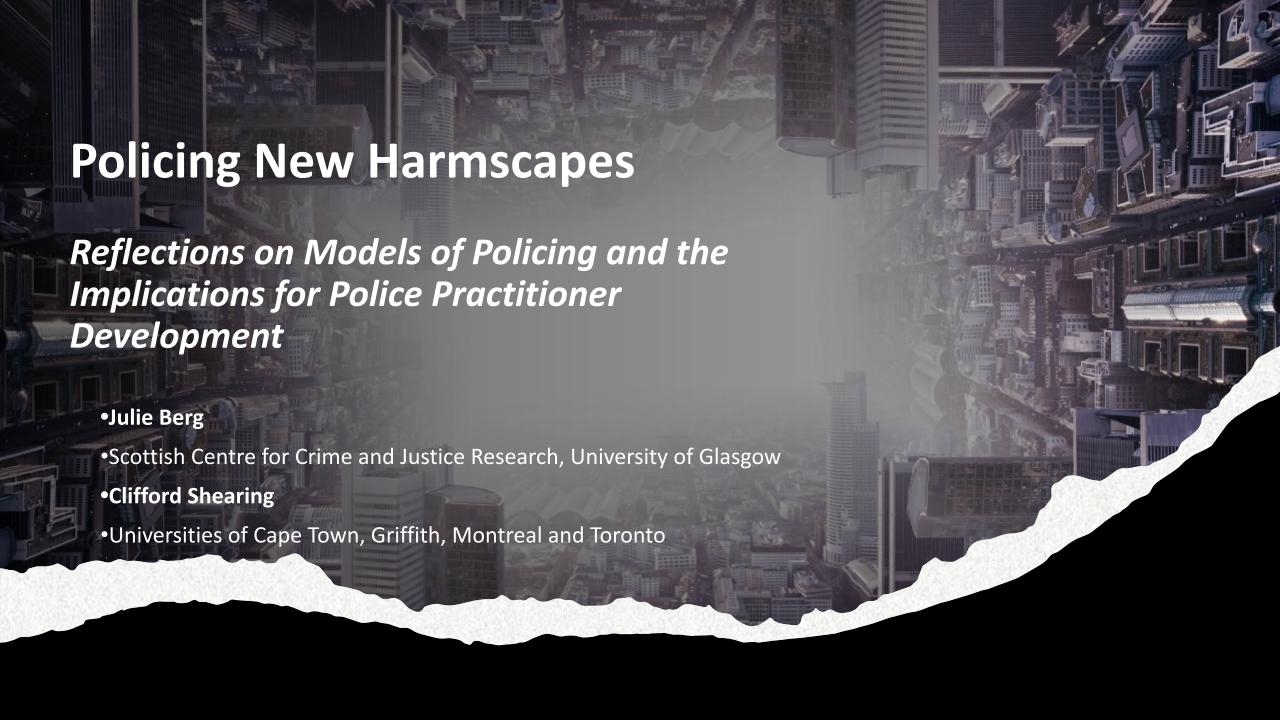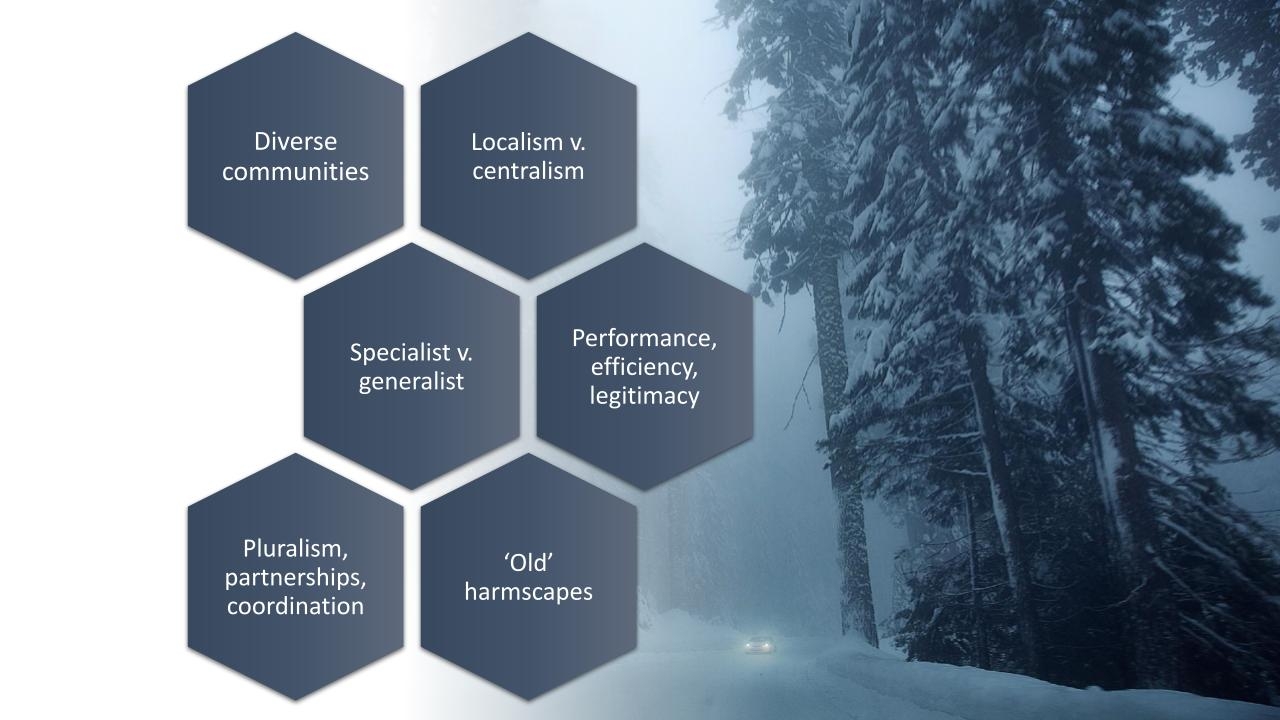Policing New Harmscapes: Reflections on Models of Policing and the Implications for Police Practitioner Development


Policing New Harmscapes: Reflections on Models of Policing and the Implications for Police Practitioner Development, is the title of the presentation by Dr Julie Berg & Prof Clifford Shearing, delivered by Julie at the Scottish International Policing Conference - Contemporary Policing Demand: Enhancing Capacity, Capability, and Resilience. The conference took place in Edinburgh from the 23rd to 24th May 2022 and was organised by the Scottish Institute for Policing Research.
Summary of the talk:
Anthropocene and Novacene
In this presentation Julie and Clifford reflect upon the rise of two harm landscapes, or what they term ‘harmscapes’. They argue that these harmscapes are particularly relevant today i) first, because of their global reach, and ii) second, because of the significance of their impacts on safety and security. One of these developments has been the emergence a new earth that is being called the Anthropocene, to recognise the role that we humans have had in shaping this new earth. Perhaps the most obvious and widely recognised of these Anthropocene developments is ‘climate change’. The earth has been heating up and this heating is bringing about climatic shifts that are leading to a new normal characterised by more extreme weather related events. Think: wildfires, droughts, heat waves, cyclones, flooding and so on.
One of the terms that has been used to recognise this new normal has been to term this new age an ‘Age of Catastrophe’. These developments have emerged as something of a shock, a shock some have termed the ‘shock of the Anthropocene’.
The second global development is the emergence of a new digital reality, that James Lovelock has termed the Novacene, but that also has been referenced by terms such as Metaverse and Digiverse. A crucial feature of this has been the emergence of new intelligences. And these new cyber spaces, like the Anthropocene, are bringing with them new harmscapes. And together these new harmscapes are challenging policing organisations and affecting both their philosophies and their practices.
Challenges to contend with:

Besides these new harmscapes, there are also a range of other challenges to contend with:
· Diverse communities
· Localism v. centralism
· Specialist v. generalist
· Performance, efficiency, legitimacy
· Pluralism, partnerships, coordination
· ‘Old’ harmscapes
Two developments in policing have emerged in response to these evolving harmscapes.
Nodal policing
The first of these developments is what might be thought of as ‘nodal policing’. In this form of policing in which public police deliberately position themselves as one node among many within a broader ‘web of policing’. This is done to enable policing to mobilise and integrate a broad set of knowledges and capacities in promoting safety and security. The idea here has been to extend what has been thought of as ‘whole of government’ policing arrangements to include ‘whole-systems’ or whole-of-society’ policing. Essential to this form of policing is the idea that effective policing requires the inclusion of a wide range of capacities and knowledges. This form of policing has a long lineage that includes developments such as ‘problem-oriented policing’ and what might be thought of as ‘guardianship policing’.
Resilience policing
A second development is what is being termed ‘resilience policing’. With resilience policing the focus of policing is enhancing the ability of social units, for example, communities, to respond to, and recover from, disasters. For example, from climatic disasters and cyber-attacks. The focus of resilience policing is not simply to utilise multiple sources of capacity and knowledge but to proactively build these resources to enhance resilience, that is to enhance the capacity of social units, for example, territorial communities or sectors such as say the banking industry, to respond to and recover from disasters. As with nodal policing this focus on enhancing resilience builds upon and extends a long lineage of developments that have sought to enhance a preventative emphasis within policing.
Cross-cutting themes
Several themes can be identified that run across these developments.
· Shifts in mentalities – socio-material world
One of these themes is a recognition that the worlds being policed, and from which policing resources are drawn, are not simply social worlds but socio-material worlds that are made up of both human and non-human actants, to use Bruno Latour’s term.
This focus on both human and non-human actants, is by no means new to policing. For instance, considerable research has taken place within criminology under the sign of ‘environmental criminology’ or crime prevention through environmental design, that has looked specifically at the mobilisation of non-human actants as policing assets.
What is new, is the extent to which this policing mindset pervades Anthropocene and Novacene policing.
· Radical polycentricity/pluralism
A second cross-cutting theme of nodal and resilience policing is that policing is becoming radically polycentric – meaning multiple centres of engagement. Not only is networked policing the order of the day, but there has been an explosion of policing agents and policing collaborations/partnerships as well as a multiplication of policing assemblages.
An indicator of this radical pluralisation has been a proliferation of the term ‘securities’. In the past security was generally conceived of in the singular. This was evident in phrases such as, ‘the maintenance of order’, ‘keeping the peace’, and ‘the governance of safety and security’. What we are seeing today is a proliferation of ‘securities’ that we might think of as fracturing the established sense of ‘safety and security’. Examples of these emerging securities include, ‘climate security’, ‘water security’, ‘energy security’, ‘food security’, ‘infrastructure security’ and so on.
As these developments have unfolded established security professionals, like the public police and private security organisations have not remained static. For instance, the public police appear to be loosening their established tight coupling to the criminal justice assemblage and engaged in couplings with other policing assemblages and other ‘securities’.
· Quest for resilience
What has also emerged is that the quest for resilience (as opposed to for instance crime reduction) has become the central objective of policing in the Anthropocene and Novacene in the face of uncertainty and catastrophe.
A conceptual shift that is becoming evident in policing arenas is an increasing focus on agility and adaptability. This shift has led analysts to use terms such as ‘adaptive policing’.
Policing harmscapes: capability and skills
Our aim in presenting these two sets of developments has been to reflect on how a shift in thinking within policing assemblages and their nodes as they develop responses to shifting harmscapes.
Vision of 21st century policing
What is emerging as a consequence of this thinking is a re-imagining of the nature of the policing web.
What is emerging is a re-conception of the public police from the idea that the police should provide a comprehensive service to a conception that conceives of the public police as filling a niche role within the web of policing. Shifts in organisational arrangements
This rethinking is leading to a re-envisaging of organisational arrangements within the web of policing, and within nodes, as nodes position and re-position themselves within the web of policing.
Shifts in mentalities, skills, training
As the landscapes of policing have been changing so too have the objectives of policing agencies. And at the centre of these changes has been the emergence of resilience as a central objective of policing.
